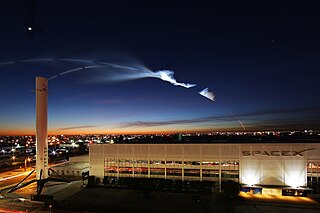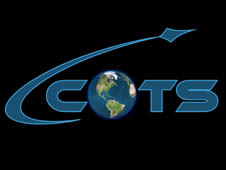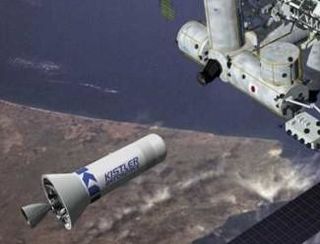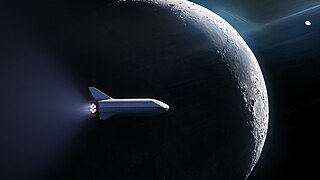Related Research Articles

Private spaceflight is spaceflight or the development of spaceflight technology that is conducted and paid for by an entity other than a government agency.

Space Exploration Technologies Corp. is an American aerospace manufacturer, a provider of space transportation services, and a communications corporation headquartered in Hawthorne, California. SpaceX was founded in 2002 by Elon Musk with the goal of reducing space transportation costs to enable the colonization of Mars. SpaceX manufactures the Falcon 9 and Falcon Heavy launch vehicles, several rocket engines, Cargo Dragon, crew spacecraft, and Starlink communications satellites.

Falcon 9 is a partially reusable two-stage-to-orbit medium-lift launch vehicle designed and manufactured by SpaceX in the United States. The latest version of the first stage can return to Earth and be flown again multiple times. Both the first and second stages are powered by SpaceX Merlin engines, using cryogenic liquid oxygen and rocket-grade kerosene (RP-1) as propellants. Its name is derived from the fictional Star Wars spacecraft, the Millennium Falcon, and the nine Merlin engines of the rocket's first stage. The rocket evolved with versions v1.0 (2010–2013), v1.1 (2013–2016), v1.2 Full Thrust (2015–present), including the Block 5 Full Thrust variant, flying since May 2018. Unlike most rockets in service, which are expendable launch systems, since the introduction of the Full Thrust version, Falcon 9 is partially reusable, with the first stage capable of re-entering the atmosphere and landing vertically after separating from the second stage. This feat was achieved for the first time on flight 20 in December 2015. Since then, SpaceX has successfully landed boosters over a hundred times, with individual first stages flying as many as eleven times.

Commercial Orbital Transportation Services (COTS) was a NASA program to coordinate the development of vehicles for the delivery of crew and cargo to the International Space Station by private companies. The program was announced on January 18, 2006 and successfully flew all cargo demonstration flights by September 2013, when the program ended.

The SpaceX Dragon, also known as Dragon 1 or Cargo Dragon, was a class of partially reusable cargo spacecraft developed by SpaceX, an American private space transportation company. Dragon was launched into orbit by the company's Falcon 9 launch vehicle to resupply the International Space Station (ISS).

Rocketplane Kistler (RpK) was a reusable launch system firm originally based in Oklahoma. It was formed in 2006 after Rocketplane Limited, Inc. acquired Kistler Aerospace. NASA announced that Rocketplane Kistler had been chosen to develop crew and cargo launch services. However, having missed financial milestones NASA terminated funding for the project. It filed for chapter 7 bankruptcy in 2010.
The following outline is provided as an overview of and topical guide to the aerospace field:

The Boeing CST-100Starliner is a class of two partially reusable spacecraft designed to transport crew to the International Space Station (ISS) and other low-Earth orbit destinations. It is manufactured by Boeing for its participation in NASA's Commercial Crew Program (CCP). The spacecraft consists of a reusable crew capsule and an expendable service module. As of February 2022 Starliner has not flown a crewed mission.

Space Act Agreements are a type of legal agreement specified in the National Aeronautics and Space Act of 1958 that uniquely empowers the National Aeronautics and Space Administration (NASA) to work with any entity that enables fulfillment of the Administration's mandate. As recently as the 2010 authorization of :

Development of the Commercial Crew Program began in the second round of the Commercial Crew Development (CCDev) program, which was rescoped from a technology development program for human spaceflight to a competitive development program that would produce the spacecraft to be used in the Commercial Crew Program to provide crew transportation services to and from the International Space Station (ISS). To implement the program NASA awarded a series of competitive fixed-price contracts to private vendors starting in 2011. Operational contracts to fly astronauts were awarded in September 2014 to SpaceX and Boeing. Each company performed an uncrewed orbital test flight in 2019, and operational flights started in November 2020.

Prometheus was a proposed crewed vertical-takeoff, horizontal-landing (VTHL) lifting body spaceplane concept put forward by Orbital Sciences Corporation in late 2010 as part of the second phase of NASA's Commercial Crew Development (CCDev) program.

Liberty was a 2011 launch vehicle concept proposed by Alliant Techsystems (ATK) and Astrium for phase 2 of the NASA Commercial Crew Development (CCDev) program intended to stimulate development of privately operated crew vehicles to low Earth orbit.

t/Space was an American aerospace company which participated in NASA's Commercial Orbital Transportation Services (COTS), and later, Commercial Crew Development (CCDev) programs for delivering cargo and crew to the International Space Station. The company was headquartered in Reston, Virginia.

The Falcon 9 v1.0 was the first member of the Falcon 9 launch vehicle family, designed and manufactured by SpaceX in Hawthorne, California. Development of the medium-lift launcher began in 2005, and it first flew on June 4, 2010. The Falcon 9 v1.0 then launched four Dragon cargo spacecraft: one on an orbital test flight, then one demonstration and two operational resupply missions to the International Space Station under a Commercial Resupply Services contract with NASA.

Lunar tourism may be possible in the future if trips to the Moon are made available to a private audience. Some space tourism startup companies are planning to offer tourism on or around the Moon, and estimate this to be possible sometime between 2023 and 2043.
The Mars race; or race to Mars; or race for Mars; is the competitive environment between various national space agencies, "New Space" and aerospace manufacturers involving crewed missions to Mars, land on Mars, or set a crewed base there. Some of these efforts are part of a greater Mars colonization vision, while others are for glory, or scientific endeavours. Some of this competitiveness is part of the New Space race.

This is a corporate history of SpaceX, an American aerospace manufacturer and space transport services company founded by Elon Musk.

The dearMoonproject is a lunar tourism mission and art project conceived and financed by Japanese billionaire Yusaku Maezawa. It will make use of a SpaceX Starship on a private spaceflight flying a single circumlunar trajectory around the Moon. The passengers will be Maezawa, 8 civilians, and one or two crew members. The project was unveiled in September 2018 and the flight is expected to occur no earlier than 2023. The project objective is to have six to eight passengers travel with Maezawa for free around the Moon on a six-day tour. Maezawa expects that the experience of space tourism will inspire the accompanying passengers in the creation of something new. The art would be exhibited some time after returning to Earth to help promote peace around the world.
Starship HLS is a lunar lander variant of the Starship spacecraft that will transfer astronauts from a lunar orbit to the surface of the Moon and back. It is a critical element of the Artemis program to land a crew on the Moon. On the Artemis 3 mission, A Super Heavy booster will launch an HLS into low Earth orbit, where it will be refueled by multiple Starship tanker spacecraft before boosting itself into a lunar near-rectilinear halo orbit (NRHO). There, it will rendezvous with a crewed Orion spacecraft that will be launched from Earth by a Space Launch System (SLS) launcher. A crew will transfer from Orion to HLS, which will descend to the lunar surface for a stay of several days which will include five or more EVAs. It will then return the crew to Orion in NRHO.

The Commercial Crew Program (CCP) provides commercially-operated crew transportation service to and from the International Space Station (ISS) under contract to NASA, conducting crew rotations between the expeditions of the International Space Station program. American aerospace manufacturer SpaceX began providing service in 2020, using the Crew Dragon spacecraft, and NASA plans to add Boeing when its Boeing Starliner spacecraft becomes operational some time after 2022.
References
- ↑ Kennedy, Lisa (January 26, 2022). "'Downfall: The Case Against Boeing' Review: Damning Aviation Doc Feeds Your Fear of Flying". Variety. Retrieved March 6, 2022.
- ↑ Pasztor, Andy (February 24, 2010). "Space Pioneer Burt Rutan Blasts NASA Plan". The Wall Street Journal . Retrieved October 13, 2019.
- ↑ Rutan, Burt. Burt Rutan Issues Clarification on Wall Street Journal Remarks, SpaceRef.com, 26 February 2010
- ↑ Pasztor, Andy (June 6, 2010). "SpaceX Illustrates Privatization Risk". The Wall Street Journal . Retrieved October 13, 2019.
- ↑ Loizos, Connie. Elon Musk Weighs in On WSJ Piece, and Future of SpaceX, 8 June 2010
- ↑ GAO-11-692T
- ↑ NASA Commercial Orbital Transportation Services (COTS)
- ↑ NASA Commercial Crew Development Program (CCDev) Round 2 Milestone Schedule
- ↑ NASA Commercial Crew Development Program (CCDev) Round 2
- ↑ NASA's Commercial Crew Program Progressing for Future of U.S. Human Spaceflight
- ↑ "2007 Gerald Loeb Award Winners Announced by UCLA Anderson School of Management". Business Wire . June 25, 2007. Retrieved February 1, 2019.